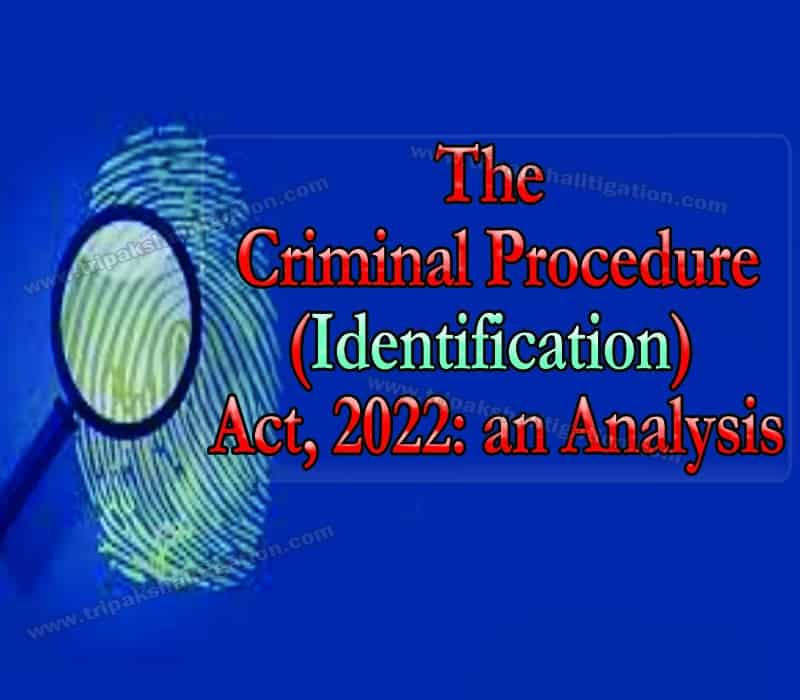The Act was passed by the Parliament in April 2022. This new Act replaces the old colonial law and it authorizes the police officers to take measurements of people convicted, arrested, or facing trial in criminal cases. It also includes their iris and retina scans and biological samples with certain exceptions. The said data can be retained for 75 years.
The New Act
The new Act gives legal sanction to the police to take of the convicts physical and biological samples and also those persons who are accused of crimes. This law permits the police to collect finger impressions, footprint impressions, palm-print impressions, photographs, iris, and retina scans. It also allows them to consider behavioral attributes that shall also include their signatures, handwriting, etc. as referred to in Section 53 or Section 53A of the CrPC.
The new Act provides authority to take measures on convicts and other persons to identify and investigate criminal matters and to preserve records. It provides legal sanction for taking appropriate body measurements of persons who are required to give such measurements. It empowers the National Crime Records Bureau (NCRB) to collect, store and preserve the record of measurements and for sharing, dissemination, destruction, and disposal of records. The Police/ Prison Officers have been given the power to take measurements of any person who resists or refuses to give measurements.
New Act v. Old Law
The new Act has replaced the old Act i.e. the Identification of Prisoners Act passed in 1920. It has a broader ambit as compared to the old law, as the latter allowed the authorities to take only fingerprint and footprint impressions of a limited category of convicted persons. Whereas, the new law allows police to collect a range of biological and identity samples from convicts as well as of those who are arrested or detained under any preventive detention law.
The old law had limitations on serious offenders but the new law shall include all the categories of criminals and accused. It can be said that the new law is stringent as compared to the old law and it has a vast scope.
The new Act done away with the condition of an offense that is punishable by one year or more of imprisonment for the “measurements” to be taken. There is an exemption that says mandatory consent for “biological samples” is to be taken, except where the accused is arrested for sexual abuse of women and children or an offense carrying a minimum punishment of seven years.
Data storage
As per the new Act the storing, sharing, dissemination, preservation of measurements, destruction, and disposal of records as mentioned above is done by the NCRB. It collects all crime data, shall also collect the record of measurements from the state government or union territory administration or other law enforcement agencies (LEA), store, preserve and destroy the record of measurements at the national level, and process such records with relevant crime and criminal records. It shall also be responsible to share and disseminate the records with any LEA. The record of measurements shall be retained in digital or electronic form for 75 years from the date of collection of such measurement.
What data can be collected?
The Act has a very wide ambit that says what data should be collected that including:
- Biometric: Fingerprints, palm prints, footprints, iris, and retina scan,
- Physical and biological samples, and
- Behavioral attributes include signature, handwriting, and could include voice samples.
Retaining data
The data would be retained for 75 years and it would be deleted only on the final acquittal or discharge of a person arrested for an offense. The retention of data in a central database and its potential use for the investigation of offenses in the future may also not meet the necessity and proportionality standards.
Illustrations
- ‘X’ is found guilty of rash and negligent driving, as per the new Act he may have his signature collected and stored in a central database for 75 years.
- ‘A’ is arrested for an offense and he refuses to give his fingerprints. He is charged to prevent a public servant to perform his duty. A’s fingerprints are forcibly taken in both cases. He is subsequently discharged from the original case. ‘A’ is guilty u/s 186 of the IPC in the second case, his fingerprints can be stored for 75 years. Hence, it may be stated that anyone who is arrested for an offense and refuses to give measurements can have the data stored for 75 years, even if the accused persons are acquitted in the main case.
Replacement of the Identification of Prisoners Act, 1920
The Criminal Procedure (Identification) Act replaced the earlier Identification of Prisoners Act, of 1920. The new Act provides that:
- NCRBis empowered to collect the record of measurements from the State Government or Union Territory Administration or any other law enforcement agencies. It shall store, preserve and destroy the record of measurements at the national level.
- The Magistrate has the power to direct a person for giving measurements to investigate or proceed under the CrPC or any other law for the time being in force.
- The police officer or prison officer is empowered to take measurements if any person resists or refuses to allow the taking of such measurements.
- The Central Government or the State Government may, by notification in the Official Gazette, make rules for carrying out the purposes of this Act.
- Persons who are convicted, arrested, or held under the preventive detention law are required to provide “measurements” to a police officer or a prison official.
- The measurement records will be retained in digital form for 75 years from the collection date.
- The records are to be destroyed in case any person, who has not been previously convicted of an offense punishable under any law with imprisonment for any term and had his/her measurements taken according to the provisions of this Act, is released without trial or discharged or acquitted by the court, after exhausting all legal remedies.
Way forward
- Safeguard against misuse: The rules would assure safeguard against any misuse of the Act including the data about identification database and biological samples, by making officers accountable for the safety of data.
- Strengthening criminal procedure: This Act is indeed a step toward strengthening the criminal procedure through consolidation of evidence/ data and increasing conviction rates.
- Suggestions: The LEA should use scientific methods to prevent and detect offenses. It is recommended that necessary training must be imparted to the investigating officers. The Right to Privacy needs to be maintained to keep national security as the prime motive.
Conclusion
The new Act brings in modern prisoner identification techniques, and the government of India has been scrutinizing data protection and privacy laws in India to ensure a robust data protection framework. Once the framework is established, the collection and retention of “measurements” under the new Act need to be by established data protection laws.








